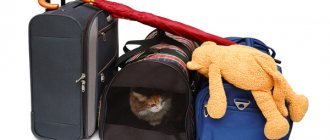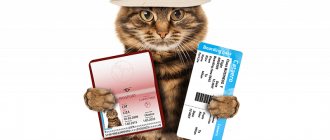In hot weather, you should never leave a cat in the car while you run out to run errands.
Even if it's for 5 minutes. In sunny weather, the air temperature in a closed car rises to +40 +50 degrees Celsius in a matter of minutes - and the cat dies or, at best, suffers a heatstroke. We always take the pet with us or leave someone in the car who will open the window or turn on the air conditioner.
In addition, in hot weather, it is recommended to take with you a special cooling mat for cats and dogs for your pet to lie on.
Transport equipment and accessories
The modern market for pet products is so extensive that you can find everything you need for almost any situation. Traveling with cats in a car has long been a part of some people’s lives, so experts have come up with and developed many devices to facilitate the process of transporting an animal.
Cat in the car
Note! It is not recommended to carry a cat in a car in your arms. This can be resorted to only if the animal is already familiar with the interior of the car, has become accustomed to it, and the trip promises to be short.
When traveling in a car, you need to purchase a special cat harness and keep it on throughout the entire journey. A leash is attached to the harness, the other end of which is tied to some object in the cabin. This is a necessary safety measure. The cat should be able to sit comfortably on the seat, but should not be allowed to move freely around the car.
Such devices are suitable for cats that can behave calmly in a car. But still, the best and safest accessory for transporting cats is a carrier bag. This is a special “container” that allows the cat to move around calmly in it, but at the same time eliminates the possibility of the animal escaping.
The carrying bag must meet the following requirements:
- The presence of holes that allow air to pass through (this can be a mesh wall or grille).
- The size of the container should correspond to the size of the cat - the animal should not be cramped.
- The presence of special holes for securing the leash.
- Stable bottom.
- Reliable walls and locks.
You should also get a small bed in advance. You should not place the cat directly at the bottom of the container.
A cat can be trained to travel without a carrier
Basic rules of transportation
At the legislative level, there are still no clear requirements regarding the transportation of animals in a car. Therefore, every car owner and at the same time the owner of a furry pet must take care of the safety of the trip on their own. It would be a good idea to take the phone numbers of a veterinarian or a person experienced in long-distance travel with animals so that you can get timely advice.
The main rule when transporting a cat is to purchase a well-ventilated carrier for the trip, which will be securely secured in the car. It is important to place it not in the trunk or near the rear window so that the animal does not suffer from heatstroke.
Basic recommendations and rules of transportation:
Just in case, you should buy your animal a leash.
- Prepare your cat in advance for the trip, especially if he has never ridden in public transport.
- Ensure comfort while traveling by providing everything you need: water;
- food;
- toys;
- tray, etc.
- veterinary passport;
What to take with you
- When traveling with a cat or dog, be sure to take with you disposable diapers, wet wipes, garbage bags, and, if necessary, a motion sickness remedy selected by a veterinarian.
- Be sure to take a supply of clean drinking water for your pet and a bowl, food and treats, dry food - even for a short trip to calm the animal.
- Toys, a spare collar and a leash will not be superfluous.
- You should always have a bandage, plaster, and antiseptic in your first aid kit.
Preparation for transportation
Before transporting an animal, you need to take care of its comfort and health. At these moments, the pet is not protected from infections and stress. Transportation is especially dangerous for animals that live permanently in an apartment and do not have access to the street.
Deworming and vaccination
Cats' immune systems can be attacked by infections while they are outside, so deworming should be done in advance. If your pet gets sick, you won't have to deal with multiple illnesses at once, and you will also minimize the unexpected manifestations of illnesses that stress causes, such as some types of lichen. Read about how to treat lichen in my other article.
When planning a long-distance trip, carry out the necessary procedures in advance and check the vaccination schedule so that the treatment period does not coincide with the time of travel.
Veterinarian consultation
Contact your veterinarian to find out which motion sickness tablets are available for your pet. Regardless of the choice of transport for the trip, as well as its duration, the animal may feel bouts of nausea and vomit.
If you know that your cat is impressionable, has a hard time with changing surroundings, or can be aggressive, purchase calming drops. They begin to be given approximately two weeks before the trip. Herbal medications are not addictive, but the need for their use and dosage should be clarified with your doctor.
Comfort and safety
Prepare the cat carrier in advance: check that the lock is working properly and that the lid is tight. If you have a regular plastic baby carrier, put some rags inside and buy some disposable diapers. Regardless of the duration of the trip, the call of nature has not been canceled, and during periods of stress the animal may defecate unexpectedly.
If you are planning a long trip by car or public transport, take a cat litter tray, cleaning bags and wet wipes with you to take care of your cat's hygiene.
On a trip, it is recommended to take your pet’s favorite things that smell like home: toys, bedding, dishes.
Purchase or prepare a harness and leash. During stops, you can offer your pet a walk, stretch and go to the toilet. A leash is important because a cat may try to run away and hide out of fear.
I have seen owners of large cats, in particular Maine Coons, who prefer to go grocery shopping or to the veterinary clinic, keeping their pet on a leash.
Experienced owners hang a tag on the cat's collar with its name and the owners' phone number. Such a minor detail will help save your nerves in the future.
What happens to a cat when it suddenly travels?
Transporting dogs in a car over long distances
An unsuspecting cat who is suddenly thrust first into a carrier and then into a car is inevitably faced with extreme stress. Therefore, owners should know in advance how cats cope with the road in the car.
A cat caught by surprise is not ready for such a test, which can negatively affect its emotional state. Especially when it comes to adults and elderly animals. It is easier for young people to adapt to changes than for adults.
Against this background, the cat may lose its appetite. Being in a prolonged state of fear will make her intimidated, nervous, perhaps even aggressive. Those who have ever carried cats in a car are well aware of the problems with the toilet: the cat may shit in the car or start burping.
To avoid such problems, owners should think in advance about how to prepare their cat for traveling by car.
Getting used to the harness, carrier and car
First, let's answer a possible objection: - Why teach - waste time? After all, you can just take the cat, put it in the carrier and go.
The fact is that a sudden change of environment will cause extreme stress! Outwardly, it is expressed in different ways: the pet can either become quiet or behave violently. But the devastating effects of stress can affect both the psyche and overall health!
Therefore, kittens should be accustomed to the necessary “attributes,” and this is easy to do while they are small. After all, in the future there will still be trips, at least to a veterinarian. And even more so if regularly - to dachas, on vacation, to exhibitions, etc.
If it didn’t work out in advance, you’ll have to instill new skills now. It’s just that, as in any business, gradualness is needed here.
TO THE HARNESS...
It will be useful for securing the cat in the back seat (if you can’t train it to carry it). And it is necessary for safety! You never know why an animal can get scared, rush out of place and injure you, and even run away?!
By the way, the traffic rules do not impose any special requirements for transporting animals, but the main condition is that the pet should not interfere with the driver and thereby endanger everyone. That's why strict order is needed on the way!
And when walking during stops, you can’t do without a leash and a reliable harness. But not in the form of a collar, like here in the photo! After all, if a cat backs away in fear, then it will easily pull its head out of it and... remember the name!
To get used to the “equipment” this way: first put it on at home for 10 minutes, then attach a leash and just walk around the apartment, and only then, starting from 2-3 minutes, go out into the yard on the grass.
Over the course of 2-3 weeks, regularly increase the duration of walks until complete adaptation. Over time, be around more people more often, also close to the highway, to familiarize the animal with the smell, noise and sight of cars.
TO CARRY...
We act in the same way - observing moderation and gradualness!
First, place a new, spacious and reliable container in a visible place. The cat will get to know him, then begin to go inside and even sleep there. Then the time will come to take the house and the cat outside, not forgetting to visit crowded places and take public transport.
On the advice of a veterinarian, you can take a course of sedative drops. On the day of departure, do not feed him (he may get motion sickness and vomit on the way), but give him something to drink and give, for example, 15 drops of “Kot Bayun”. Place a medical diaper secured with tape and a favorite toy on the bottom of the cage.
On the way, at stops, take him out for a walk (especially if he screams or feels unwell), give him some water (the hotter it is in the cabin, the more often!) and feed him delicious food. And also sit next to you, calm you down, keep an eye on you.
Do not use boxes and bags, but only spacious houses with excellent ventilation:
Attention! Do not allow the animal to overheat in the cabin, especially long-haired animals. Signs will be: rapid breathing with an open mouth; increased body temperature; apathy; vomit. Then run your wet hands over the cat's fur. Ventilate the interior. Do not place the carrier near the stove in winter. In summer, do not leave it in the sun in a closed car... even for 5 minutes!
TO BEING IN THE CAR
For the first time, it will probably be enough to let him sniff the entire interior of the salon? Here in the photo: the “correct” - tightly grasping - harness.
Next time, you can start the engine so that the animal gets used to its sound and vibration. And then take a short ride and see the reaction of the little passenger. And so - repeatedly, including by bus, until he finally gets used to it and is “ripe” for traveling long distances.
How long will it take? It’s different for everyone: up to several weeks and even months.
How to prepare your cat for a trip
How to transport a cat on a train: Russian Railways rules
Preparatory activities should begin no later than two months before the planned trip. The first stage is vaccination. It must be preceded by treatment for worms (10 days before vaccination).
3-4 weeks after the first vaccination, the animal is given a second vaccination. After this, you must wait for the incubation period (quarantine), which lasts about two weeks. During this time, the cat should develop and strengthen its immunity.
Only after these procedures can you organize a long trip by car.
You need to accustom your cat to the car from childhood
What and how to feed your pet while traveling
The cat's food during the trip should be calculated based on the duration of the intended trip. For example, if you are expecting a move that will take no more than 5-7 hours, then you don’t have to feed the animal in the car to avoid unpleasant situations with motion sickness.
When the journey takes a day or more, it will be necessary to prepare rations for the four-legged passenger. It is recommended, if possible, to take with you on the road the food that the cat is accustomed to. But these should not be strong-smelling or perishable products. The ideal option would be dry or wet food. Feeding regimen: small portions of food several times a day (up to 4 feedings).
Note! In addition to food, the cat should have constant access to fresh water. Especially when it comes to traveling in hot summer weather.
Accompanying documents
It is clear that you will not need documents to travel to the country or on another short trip. However, when moving long distances, you will have to worry about having special documents.
You need to have a veterinary passport with you, which indicates that the animal has all the necessary up-to-date vaccinations. Vet. a passport, unlike a pedigree, can be obtained without any problems at the nearest veterinary clinic. Even outbred domestic cats should have it and it is done at any age.
If you are planning a long trip that involves traveling abroad, you will need more documents. Each country requires its own list of required documents and you need to get acquainted with them individually. When traveling abroad, you may need to have a chip, a certificate of absence of rabies, a health certificate (international standard), an import declaration and some other documents.
Frequently traveling cats are not afraid in the car
How to train your pet to travel in a car
First of all, you should follow the traffic rules. The car should not suddenly turn or brake. The animal must feel safe. Otherwise, it may get scared once and for all.
I recommend: Stroller for cats: fashion or necessity? (6 photos 2 videos)
You should start with short trips, gradually increasing the time you spend in the car.
On a note! You can rearrange your pet's sleep schedule so that he plays at home and only sleeps in the car.
It is recommended to take one or two of your cat’s favorite toys with you to the salon so that he has something to occupy himself with. He won't necessarily play with them. But the constant presence of familiar objects nearby defuses the situation.
In conclusion, it is worth noting that transporting a cat in a car is not an easy task, but with proper preparation it can be managed. If the animal will be transported in the car regularly, then it is better to accustom it to this from childhood.
We provide food and drink
Many owners prefer not to feed their pet on the road, but if the journey is long and the animal is accustomed to eating at a certain time, then you should worry about providing it with food and water.
The best food option. When choosing food, it is better to give preference to dry food or small packages with pieces in sauce, canned food. They will not spoil even if there is no refrigerator, and the cat will not get food poisoning. Fresh water is a must. An animal is thirsty because:
- experiences stress and “sweats” a lot;
- loses fluid during vomiting during motion sickness;
- overheats inside the car;
- eats dry food.
When to feed?
If the trip takes a little time, then it is better to feed the cat 30-60 minutes before departure.
On a long journey, the animal is fed according to a schedule or when the pet wants to eat. Water must be in the access area at all times. For convenience, you need to take with you bowls for food and water, from which the cat eats at home. Familiar containers will calm the cat.
Possible problems and advice from experienced travelers
Microchip implantation
The main idea of chipping is to make it easier to find “lost items” so that if found, they can be returned to the owner. Also, all information about a given belly is recorded on the chip, including its vaccinations, diseases and other data.
What does a cat need on the road?
In order for your pet to survive a long trip, you need to have some items with you. Be sure to stock up on the following:
All of these items will be useful, especially during a long trip.
I recommend: How and with what to clean a cat’s ears at home
Is a container required for transportation?
A bag for transporting cats is a must, regardless of the chosen transport. It is not recommended to take out an animal while traveling, since in a state of fear it can simply run away, bite, scratch and escape from your hands.
The nuances of transporting kittens
Sedatives for cats
Using sedatives will reduce your cat's stress. It is advisable to coordinate the choice of a specific drug with your veterinarian. If you plan to travel by plane, sedatives for cats during transportation can be dangerous.
An overdose of the drug can also only cause problems, and sometimes even cause death.
How to prepare a cat for flight
For several days, the cat’s food should be limited, but not completely. Access to water must remain unrestricted. It is worth preparing a carrier, toys and other necessary items in advance.
Should you feed and water your cat before and during the flight?
It is better not to feed the animal during the day or during the flight. The cat is under stress and therefore will not be interested in food. The last feeding should be four hours before departure.
Possible problems during the trip
If the owner is thinking about how to transport a cat in a car without a carrier, then he should familiarize himself with the list of problems that may arise during the trip.
How to remove a cat from a tree: an effective method
Cats tend to be afraid of unfamiliar surroundings. Therefore, even a calm and balanced animal can forget about exemplary behavior and scratch the owner’s hands and exposed parts of the body not out of malice, but out of fear.
Often there are problems with the toilet. You should take care in advance about the availability of a tray, bag, filler and, of course, be patient, especially when it comes to traveling with a kitten. Pets accustomed to walking can be periodically taken outside to do their business.
Note! Wondering how to transport a cat in a car over long distances, some owners decide to sedate it with sedatives for the duration of the trip. This is a good way for owners of lively cats.
What you need to transport a cat by train
Which car is suitable: passenger or baggage
The only passenger carrier in our country is Russian Railways. If such a move is planned, it is better to find out in advance the existing rules of this state company in the field of transporting animals.
If you are using a shared carriage where the passenger is seated, you will need to pay extra for the cat and present a transportation ticket (receipt). There are other types of wagons that have different requirements.
Table of conditions for transporting animals in Russian Railways cars.
Cost of transporting cats on a train
If we are talking about high-speed trains, you will also have to pay extra. The “swallow” charges a fixed fee of 150 rubles. In Sapsan it is already included in the ticket price.
Transportation on long-distance trains
When transporting an animal, the owner must ensure sanitary and hygienic requirements, as well as the safety of other passengers.
Long-distance travel is considered to be a route longer than 700 km. The cost of transporting a cat will depend on the distance, for example, for a distance of more than 12,000 km the cost will be 3,000 rubles. To ensure your pet’s comfort, you must fulfill a number of requirements:
- ensure constant access to water;
- carry anti-motion sickness pills;
- If possible, at stations with a large parking lot, take the container with the animal into the fresh air and give her the opportunity to go to the toilet.
Also, when moving long distances, it is worth considering the cat’s diet. It is optimal to choose dry ready-made food. You should not feed your pet too often.
Transporting cats unaccompanied
- cage or special carrier;
- veterinary documents;
- food, water, hygiene products for the cat.
The cost of such a service is determined by the distance. During the entire journey, the animal will be under the supervision of train staff.
If your cat gets sick in the car
Some cats get carsick. Signs that this is happening to your pet include:
- drooling and constant licking of the mouth;
- vomit;
- the cat breathes through its mouth.
2-3 hours before the start of the trip, do not feed the cat so that it has nothing to vomit. But if this does happen, you should always have a large amount of wet wipes ready to clean the interior.
In addition, you can use cat tablets against motion sickness, which are sold in veterinary pharmacies.
Rules for transporting cats in different vehicles
The cat is transported in a container or bag. Check that she can stand and lie in it freely, that the doors are locked, and that the bottom does not leak. To be on the safe side, place an absorbent mat in the cage.
The nuances of transporting a cat in different types of transport:
You can transport two pets in one container if each of them weighs up to 14 kg, and three if all of them are not older than 6 months.
How to transport a kitten
In order for the baby to behave calmly, veterinarians recommend placing the bedding on which he slept at home or his favorite toy at the bottom of the container.
Contraindications to the use of sedatives
Do not forget that any remedy, even homeopathic, has a number of contraindications. Therefore, it is still worth giving certain medications, as mentioned above, after consulting a veterinarian. In addition, the use of sedatives during pregnancy, feeding kittens, and under the age of one year will be absolutely prohibited. Contraindications for health reasons include: renal or genitourinary pathologies, problems with blood pressure and vision, periods of illness of the animal. Also, under no circumstances should you give such a popular valerian to cats. Along with catnip, it causes narcotic intoxication and harms the health of the animal.
What to feed your pet on the road
Even cats accustomed to traveling often refuse to eat on the road. Don't force your pet: this is normal for short trips. Feed him about six hours before leaving. In transport, animals often get sick and may vomit. On a long journey, take the usual dry food that will provide complete nutrition, for example, PROPLAN.
In a stressful situation, a kitten is able to not drink for the whole day. Try to get him drunk. Especially if you are traveling by plane or during the warmer months. Heat and dry air lead to dehydration, which is dangerous for the cat's health. At the new place, mix water with “home water”. A sudden switch to unusual water sometimes causes indigestion.
What documents are needed to transport a pet?
- Veterinary passport
with data on the animal and owner, a note on vaccinations and treatment against parasites. It can be issued at any veterinary clinic. Kittens are usually given a passport upon their first vaccination. Make sure you make notes about the drug administered and the date of vaccination. It also includes data on surgical interventions, features of color and body structure, and microchipping. To travel abroad, apply for an international passport in two languages. If you have lost your pet's document, it is better to make a new one. The clinic stores information about the procedures performed, but the stickers from the vaccine ampoules cannot be restored.
Keep in mind that document preparation takes time: take care of it in advance.
- A certificate in Form F-1
confirming that you have passed a veterinary examination is required for traveling abroad. To receive it, the cat must be in satisfactory health. All vaccinations and procedures were completed on time and included in the passport. The examination is carried out no earlier than 30 days after the last vaccination. The certificate contains information about the owner, whether the cat has undergone quarantine and an approximate travel route. Therefore, for each new trip you will have to arrange it again. Document readiness is 1-3 days. At the border it will be exchanged for an international certificate. Passing the inspection is not just a formality. It helps make sure your pet can handle the trip without harm.
The passport can be issued at any veterinary clinic, and the F-1 certificate can only be issued at the state clinic. The service is paid, the cost varies in different clinics.
What to do to prevent the omen from coming true
If a sign carries a negative connotation, do not be upset; sometimes the effect of a sign can be minimized. First, you need to calm down and remember that signs do not come true in 100% of cases. There are many ways to avoid the bad effects of omens:
- Use the anti-omen. You can knock on wood, spit over your left shoulder three times, look in the mirror;
- Try to mentally “erase” the sign. In consciousness, concentrate on the negative moment and forget it. You can write a superstition on paper and set the paper on fire. With ashes, everything bad is neutralized;
- Devalue the sign. You should try with all your might not to believe in the effect of the sign, to convince yourself of it.
Some people come up with their own effective ritual to avoid the influence of superstitions. There are many ways, the main task is to switch your attention from a negative attitude to a positive one.
The influence of the season on the meaning of the sign “the cat sat on the car”
Cats can be found on the street in both heat and cold, but the meaning of the superstition changes depending on the time of year:
- Spring. There is an opinion that in the spring a cat on a car means possible malfunctions; it is worth checking the condition of the car and protecting yourself from danger;
- Autumn. If a cat climbs onto a car in the fall, it means it feels the impending cold. The weather will soon change, leading to a general cooling;
- Winter. A cat in winter climbs onto a car and licks its tail - to a snowstorm and blizzard;
- Summer. In the summer, a cat in a car brings good luck. The exception is black cats; according to signs, they are considered a harbinger of trouble at any time of the year.
Is it necessary to microchip an animal?
Microchipping is not necessary for traveling within Russia. But without it you won’t be able to travel abroad. The best age for the procedure is 11-12 months, but it is safe to put a chip on an adult animal.
Information is entered into the Russian database automatically. Entry into foreign countries should be controlled through the Animalface website. This database is combined with the international search engine Petmaxx. If your pet's chip cannot be checked at the border, you will not be allowed into the country with it.
Rabies vaccination must be done after microchipping or simultaneously with it. If the cat has been vaccinated before, the procedure will have to be repeated.
First thing
First of all, make sure that it is not easier to leave the cat at home. Here are some examples when it is better not to disturb a cat:
- The cat has nowhere to live. Imagine that you are going to visit relatives, and they are allergic to cats. It is easier to leave a cat in a hotel in your hometown than to rent out a hotel while visiting.
- Long quarantine. When crossing some borders, animals have to remain in quarantine for up to six months.
- Nervous character of the animal. Some cats are simply pathologically afraid to leave the house. Especially if they have never left the apartment, which is not uncommon now.
If your cat is an avid traveler, and the same cat lovers without a hint of allergies are waiting for you at the place of arrival, get ready for a trip. Cats have no business lying on the sofa!
To take or not to take—that is the question!..
If road trips are a common thing for your mug, then you can and should! Why leave the baby in the wrong hands for a long time? After all, she will miss you, and you will miss her. It's better - together!
And when exactly you can’t take it with you? For example, if:
- the pet will have nowhere to live (what if someone in the family where you will be staying is allergic to wool?);
- in the country where you are planning a vacation or business, there is a very long quarantine (sometimes up to six months!);
- your pet is such an avid homebody that she is seriously and even pathologically afraid to leave her home; and if you still can’t get her accustomed to being in a carrier, then to a car (exception: moving to another house).
And in other cases - why not? And stop pushing the sofa!
So, it’s decided - let’s go! Where to start preparing a cat?
Where did the superstition “the cat sat on the car” come from?
Most signs have their origins in ancient customs and historical events. For example, previously mirrors and salt were expensive, so spilling salt and breaking a mirror was considered bad luck.
Superstitions associated with cats also have historical background. In the Middle Ages, people died en masse from epidemics, infections carried by rats, including cats. Therefore, they were afraid of cats and tried to avoid them.
Each country has its own signs, they are associated with generally accepted traditions and way of life. In North Africa they believe that a black cat will bring happiness; among the Slavs it is a symbol of evil spirits and dark magic. In one country, a cat in a car is a sign of joy, in another it is a sign of misfortune. Signs are formed in the minds of the people gradually, and their meaning is transmitted and modified from generation to generation.
To believe signs or not is up to each person. You can find a logical explanation for the belief, or you can intuitively put sacred meaning into it. The sign “a cat sat on a car” was formed recently; this superstition does not have a rich past. Depending on the situation, different interpretations of the sign are possible, both positive and negative. The negative influence of superstition can be avoided, the main thing is your internal positive attitude, belief in the good and attentiveness to your safety.
How to choose a carrier
Don’t skimp on carrying: good quality will ensure the comfort and safety of your pet and ease of transportation. Make sure the door closes securely to prevent your pet from getting out. A hard plastic carrier is necessary if the animal has to be placed in the luggage compartment. In other cases, textile with a rigid frame is suitable. The kitten will be more comfortable in it. The size depends on the parameters of the pet. If he lies down freely, sits down and turns 360 degrees, everything is in order, it’s comfortable to be inside. Don’t forget about yourself: handles or straps will ensure comfortable movement of the carrier.
Before your trip, find out all the requirements for transporting furry passengers, and carefully monitor the health and well-being of your pet. Then the journey will be comfortable and safe.
How to transport a cat on a plane
Most airlines allow cats and dogs, but their requirements may vary.
It is not true that pets fly in the cargo hold along with luggage. Animals are placed in a special warm compartment. At the same time, a cat and a dog cannot fly on the same plane, so a ticket with an animal must be booked in advance. The carrier must confirm whether your cat can be carried on this flight, so book your ticket as early as possible.
You can take your pet into the salon in a container whose total weight does not exceed 8 kg. This means that the cat will most likely fly with you. You cannot take it out of the carrier.
Before boarding, the cat must undergo veterinary control, so arrive at the airport early. At the veterinary station you need to present all the documents, and the employee will make sure that the pet is healthy and safe for others. You will be given a permit and you will be able to board with your cat.
Aeroflot clarification
We will equip the place
Carrying
The most reliable and safe place for a cat during a trip is a carrier - a container with a grille for air access and a door with a secure lock.
When choosing a good carrier, you need to pay attention to:
Scientists have found that cats are often susceptible to claustrophobia. The carrier should allow the pet to follow what is happening and see its owner. Some carriers have built-in bowls or trays for food and water.
Let's make a purchase . When choosing a carrier you need:
The carrier is placed in the back seat and securely secured with seat belts so that the container cannot slide around the cabin.
Recommend: Cat Whiskers
Bed
An animal that spends a long time in a carrier or inside a car needs bedding or a mattress:
- comfortable;
- soft;
- with replaceable cover.
Harness
How to choose a harness. The correct harness should:
Harness training. It is more difficult to train an adult cat to wear a harness. It is better to start doing test walks at home, so that the animal adapts to its usual conditions and calmly endures the restrictions of freedom.











